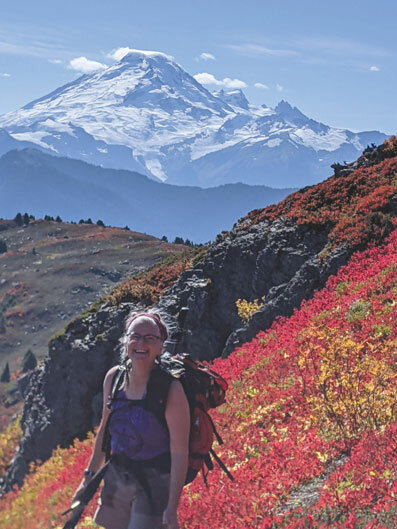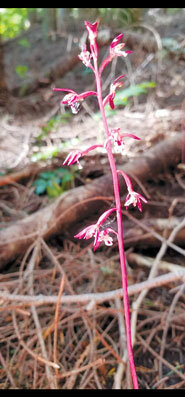 Courtesy Holly Koon
Courtesy Holly KoonWatching Holly Koon hike down a mountainside is kind of like watching someone roll a ball down a hill. She’s in free fall, trusting every footstep, no matter if the native blackberries get tangled in her feet. Suddenly, as she’s trekking through the duff in a forest of fir trees, she spots a Western Coralroot, a type of orchid. Squatting down, she brushes the magenta lip-like petals with her fingertip, “Look how beautiful,” she croons, then stands up, and continues her controlled tumble down the slope.
 Courtesy Holly Koon
Courtesy Holly KoonThis sense of wonder and complete confidence in her ability to navigate the woods began early, while recreating and working in the forests of the Olympic Peninsula. Her mom worked as a nurse while her dad, who was mostly self-employed, made a living by diving commercially for sea urchins, salvaging logs from timber areas, and farming pigs, chickens, geese and cattle, Holly and her sister often worked alongside him.
When all she wanted to do was read book number 47 of the Nancy Drew Series, her dad had her chopping thistles to keep them from taking over their field. As a teenager, he’d hire her, her sister, and their friends to throw the bark and rotten wood off the logging roads after a helicopter picked up the salvaged wood that he had cut, stripped, and loaded in slings. When they weren’t working on the farm or in the woods, they hiked, backpacked, and picked mushrooms.
Holly’s childhood sounds larger than life. On Sunday, May 18, 1980, when her sister and her were teenagers in a town near Port Angeles, they woke up to a “boom.”
Their dad yelled up the steps, “Hey, what the hell are you girls doing up there?’ When he discovered that they had been sleeping, he said, “There are two things I’ve never heard before: intercontinental missiles going off and the other one is a volcano.”
Figuring that it was a volcano blowing up, he called up his best friend, a geology professor at a local college and a pilot. His friend, who had scientific clearance to fly around Mt. Saint Helens, took them in a four-seater plane to see the aftereffects of the explosion. Below them, the Toutle River was flooded with ash and debris while rescuers did their best to save livestock and people. Even with all the adrenaline of watching the devastation caused by the explosion, Holly could barely stay awake because the air was too thin at that elevation. Their pilot friend finally said, “We gotta turn around because nobody knows what volcanic ash does to the air filters of a plane.”
Seven years after the volcano exploded, Holly spent eight seasons, from 1987-1994, working as a wilderness firefighter and Hot Shot for the Mount Baker Snoqualmie National Forest. Working on fire crew during the summers taught her to push through pain, to navigate rough terrain, and to work with a crew, but it also gave her time to pursue her degrees in education and biology. As much as she deeply cares about the woods, she also deeply cares about people, and she wanted to share the wonders of the natural world with the teenagers at Mount Baker High School where she
teaches biology.
 Courtesy Holly Koon
Courtesy Holly KoonFor many years, she juggled teaching, building a house in the woods with her husband, and raising their son with hiking, skiing, and rafting on their days off. Then Covid-19 hit. Like most people, Holly was forced to slow down. In her extra free time, she took more walks in the woods and became even more curious about the native plants and fungi that surrounded her entire life. They had always been there, waiting for her to revel in their magic in a deeper way. She watched the Western Coralroot’s life cycle. She learned more about the interconnection of the firs, cedars, fungi, and understory plants through books and online native plant groups. The more she got to know the fauna and flora in her backyard, the more important they became to her.
To feel connected to the natural world doesn’t mean it’s necessary to free-fall down a mountain side in a controlled tumble, or fly in an airplane around an exploding volcano, or even to vanquish a fire breathing dragon. To feel connected to nature means devoting time in a variety of ways. Holly’s life exemplifies this. When she’s not encouraging a sense of wonder and curiosity in her biology students, she works in the woods gathering firewood and food, shares adventures and recreates in nature with friends and family. And sometimes she just spends time in nature to revel in the beauty and mystery of the interconnection of all things. X